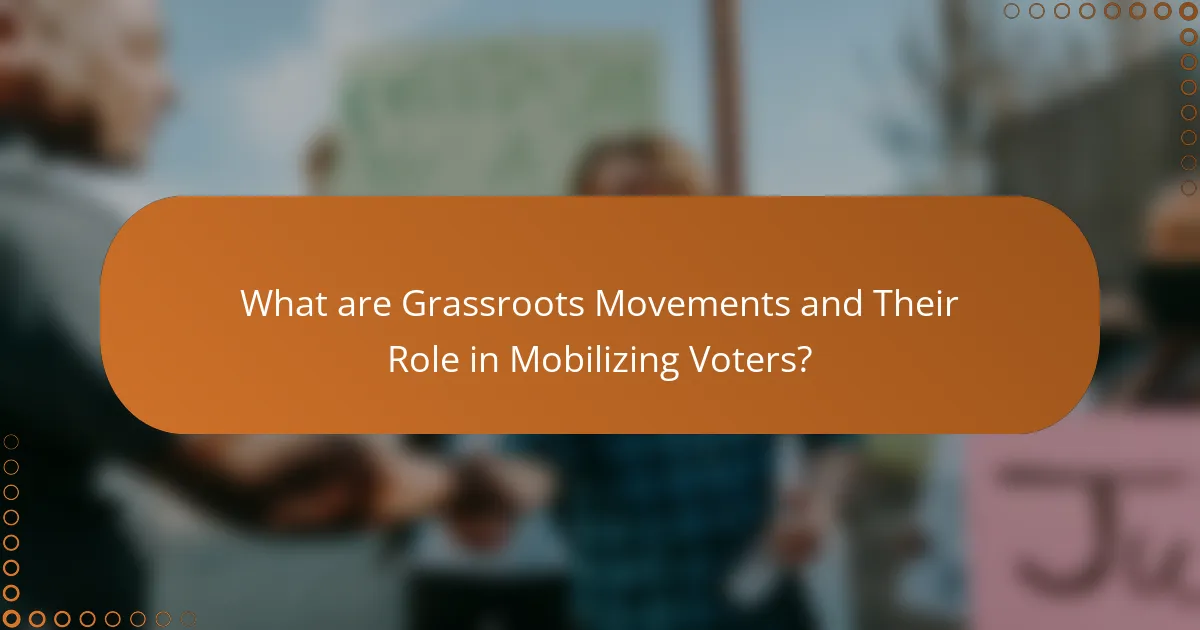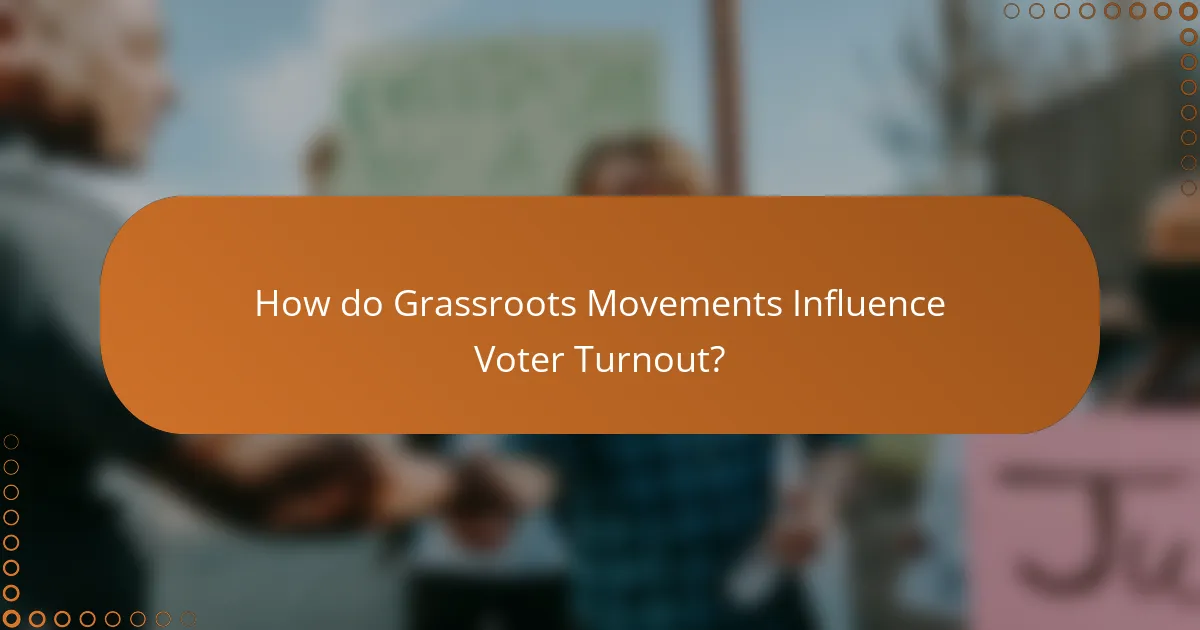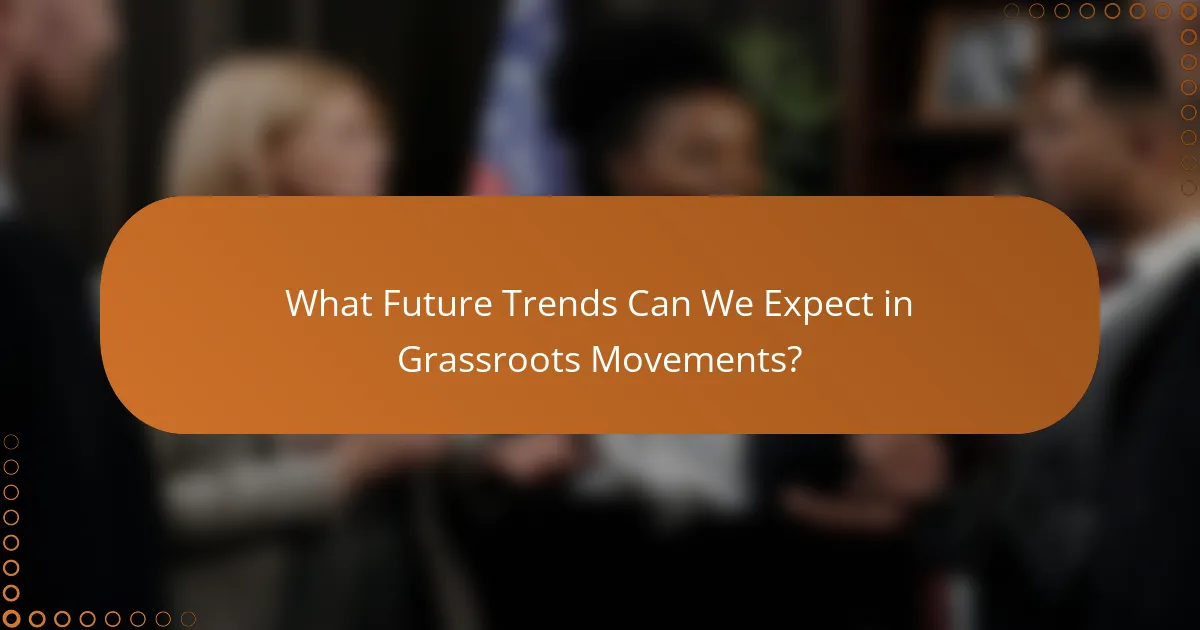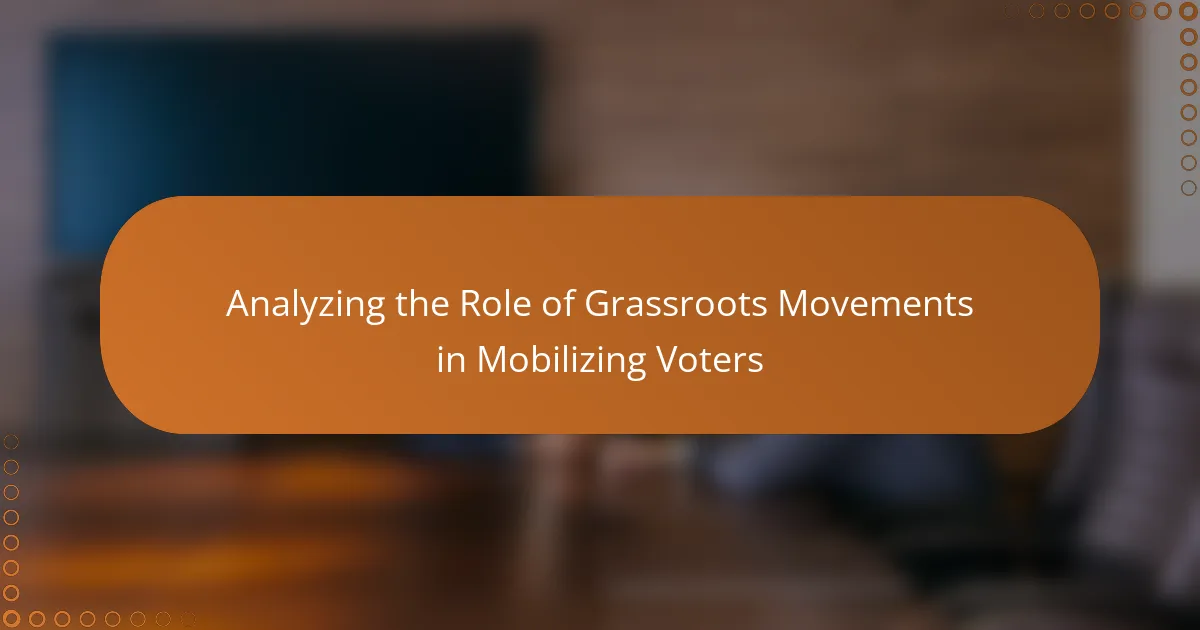Grassroots movements are organized efforts by ordinary individuals aimed at achieving social or political change, emerging primarily from local communities. These movements play a significant role in mobilizing voters by raising awareness about issues that directly impact their lives and encouraging community participation. Historical examples, such as the Civil Rights Movement, demonstrate their effectiveness in increasing voter registration and turnout. Current trends indicate a shift towards digital engagement and data-driven strategies to reach underrepresented demographics, with a focus on localized campaigns addressing specific community needs. The rise of youth activism and hybrid engagement models are expected to shape the future landscape of grassroots voter mobilization.

What are Grassroots Movements and Their Role in Mobilizing Voters?
Grassroots movements are organized efforts by ordinary people to effect social or political change. They often emerge from local communities and focus on issues that directly affect their lives. These movements mobilize voters by raising awareness about specific issues. They encourage participation through community organizing and outreach. Grassroots efforts have historically played a crucial role in elections. For example, the Civil Rights Movement significantly increased voter registration among African Americans. Research indicates that grassroots campaigns can lead to higher voter turnout. In the 2008 U.S. presidential election, grassroots organizing was pivotal in mobilizing young voters. Overall, grassroots movements empower individuals to influence political processes and drive voter engagement.
How do Grassroots Movements differ from Traditional Political Campaigns?
Grassroots movements differ from traditional political campaigns primarily in their organization and funding. Grassroots movements typically rely on community engagement and volunteer efforts. They often utilize social media and local events to mobilize support. Traditional political campaigns usually operate with significant financial backing from donors and party organizations. Campaigns often focus on paid advertisements and professional staff. Grassroots movements emphasize individual contributions and collective action. This approach fosters a sense of community ownership and participation. Research shows that grassroots movements can effectively mobilize voters, especially in local elections, by creating a personal connection to issues.
What are the key characteristics of Grassroots Movements?
Grassroots movements are community-led initiatives aimed at effecting social or political change. They often emerge from local concerns and involve active participation from individuals. These movements prioritize collective action and grassroots organizing over top-down approaches. They typically rely on volunteer efforts and grassroots funding rather than institutional support. Grassroots movements emphasize inclusivity, allowing diverse voices to contribute to the cause. They utilize social media and digital tools to mobilize supporters effectively. Historical examples include the Civil Rights Movement and environmental activism, showcasing their impact on voter mobilization. Research indicates that grassroots efforts can significantly increase voter turnout, demonstrating their effectiveness in political engagement.
Why are Grassroots Movements effective in engaging communities?
Grassroots movements are effective in engaging communities because they foster local participation and empowerment. These movements often arise from within the community, making them relatable and relevant. They utilize personal connections and shared experiences to build trust. This trust encourages individuals to participate actively. Additionally, grassroots movements often address specific local issues, increasing community investment. Research shows that when people feel their voices matter, they are more likely to engage. For example, the 2016 election saw increased voter turnout in areas with active grassroots campaigns. This indicates that grassroots efforts can directly influence civic engagement and mobilization.
What strategies do Grassroots Movements use to mobilize voters?
Grassroots movements use several strategies to mobilize voters effectively. They often rely on community organizing to build local networks. This involves recruiting volunteers who are passionate about specific issues. These volunteers engage in door-to-door canvassing to connect with voters personally. They also utilize social media platforms to spread awareness and encourage participation. Mobilization events, such as rallies and town halls, are organized to create a sense of community. Grassroots movements frequently collaborate with local organizations to amplify their reach. Data-driven approaches help identify key demographics for targeted outreach. These strategies have proven successful in increasing voter turnout in various elections.
How do social media platforms enhance voter mobilization efforts?
Social media platforms enhance voter mobilization efforts by facilitating communication and engagement among users. They allow organizations to share information about voting dates, registration processes, and candidate positions. Platforms like Facebook and Twitter enable grassroots movements to reach large audiences quickly. For instance, a study by the Pew Research Center found that 69% of adults use social media, making it a powerful tool for outreach. Social media also fosters community building, encouraging users to participate in events and discussions. Additionally, targeted advertising on these platforms can effectively reach specific demographics, increasing voter turnout.
What role do community events play in these movements?
Community events serve as crucial platforms for grassroots movements to mobilize voters. They foster engagement and build relationships within the community. These events create opportunities for information sharing and education on important issues. They often feature speakers who can inspire and motivate attendees. Participation in community events can increase voter registration and turnout. Research shows that communities with active grassroots events see higher electoral participation rates. For example, a study by the Pew Research Center found that local engagement significantly correlates with increased voter turnout. Thus, community events play an essential role in energizing grassroots movements and enhancing voter mobilization efforts.
What challenges do Grassroots Movements face in mobilizing voters?
Grassroots movements face several challenges in mobilizing voters. Limited resources hinder their ability to reach a broad audience. Many grassroots organizations operate on small budgets, affecting outreach and campaign effectiveness. Additionally, they often lack access to established networks, making it difficult to connect with potential voters.
Another challenge is overcoming voter apathy. Many individuals feel disillusioned with the political process, which can lead to low engagement. Grassroots movements must work hard to inspire interest in voting among these populations.
Furthermore, misinformation can undermine their efforts. Voters may be influenced by false information, which complicates the messaging of grassroots initiatives. Finally, regulatory hurdles present obstacles. Many areas have strict laws governing campaign activities, limiting grassroots organizations’ ability to mobilize effectively.
How do funding limitations impact their effectiveness?
Funding limitations significantly reduce the effectiveness of grassroots movements in mobilizing voters. Limited financial resources hinder outreach efforts, making it difficult to reach a broader audience. Without adequate funding, these movements struggle to organize events and campaigns. This leads to lower visibility and reduced engagement with potential voters. Research shows that well-funded movements can increase voter turnout by up to 20%. Conversely, those with limited budgets often fail to make a substantial impact. Funding constraints also restrict access to essential tools and technologies for communication. Consequently, grassroots movements may not effectively convey their messages or mobilize supporters.
What are the barriers to reaching diverse voter populations?
Barriers to reaching diverse voter populations include language obstacles, socioeconomic factors, and lack of access to information. Language barriers hinder communication with non-English speaking communities. Socioeconomic factors, such as poverty, limit access to transportation and resources for voting. Additionally, misinformation and lack of outreach contribute to voter apathy. Historical disenfranchisement creates distrust in the electoral process among marginalized groups. Studies show that targeted outreach efforts significantly improve voter turnout in diverse communities. For instance, the 2020 election saw increased mobilization efforts that led to higher participation rates among minority voters.

How do Grassroots Movements Influence Voter Turnout?
Grassroots movements significantly influence voter turnout by mobilizing communities and increasing political engagement. They often utilize local networks to inform and motivate citizens about voting. These movements can address specific issues that resonate with the electorate, making participation feel more relevant. For example, the 2018 midterm elections saw a notable increase in turnout driven by grassroots efforts focused on healthcare and education. Research by the Pew Research Center indicated that grassroots organizations effectively reached underrepresented voters, enhancing their participation rates. By fostering a sense of community and urgency, grassroots movements create a supportive environment that encourages individuals to vote.
What evidence supports the impact of Grassroots Movements on voter turnout?
Grassroots movements significantly increase voter turnout. Studies show that grassroots campaigns engage communities directly. They often mobilize underrepresented groups. For example, the 2018 midterm elections saw a 50% increase in turnout among young voters due to grassroots efforts. Research by the Harvard Kennedy School found that local organizing led to a 7% increase in voter participation. Additionally, the Pew Research Center reported that community-driven initiatives effectively raise awareness about voting. These movements create a sense of urgency and empowerment. They foster personal connections that traditional campaigns often lack.
How do Grassroots Movements create a sense of urgency among voters?
Grassroots movements create a sense of urgency among voters by highlighting immediate issues that require action. They often utilize emotional appeals to connect with voters’ concerns. This connection fosters a feeling that inaction could lead to negative consequences. Grassroots campaigns frequently employ social media to disseminate urgent messages rapidly. Statistics or personal stories are often shared to illustrate the stakes involved. For example, movements may reference upcoming elections or legislative deadlines to create a timeline for action. Mobilization events, such as rallies or phone banks, are organized to encourage participation. These activities reinforce the idea that collective action is necessary and time-sensitive.
What specific case studies illustrate successful voter mobilization?
The case studies of successful voter mobilization include the 2008 Obama campaign and the 2016 Bernie Sanders campaign. The Obama campaign utilized grassroots organizing to engage young voters and minorities. They employed targeted social media strategies and door-to-door canvassing. This approach resulted in a 5% increase in voter turnout among these demographics compared to previous elections.
Similarly, the Sanders campaign in 2016 focused on mobilizing young voters through social media and community events. They emphasized issues like income inequality and healthcare reform. This strategy led to a significant increase in voter engagement, particularly among voters aged 18-29, who turned out in higher numbers than in previous elections.
Both campaigns demonstrate the effectiveness of grassroots movements in mobilizing voters through targeted outreach and engagement strategies.
What role do volunteers play in Grassroots Movements?
Volunteers play a crucial role in grassroots movements. They provide essential support in organizing events and mobilizing community members. Volunteers help spread awareness about issues and initiatives. Their efforts often lead to increased voter registration and participation. Studies show that grassroots campaigns with active volunteers are more effective. For example, a report from the Harvard Kennedy School found that volunteer-driven outreach significantly boosts voter turnout. Additionally, volunteers help build networks and foster community engagement. Their passion and commitment drive the movement’s momentum and sustainability.
How do volunteer-driven efforts enhance community engagement?
Volunteer-driven efforts enhance community engagement by fostering connections among residents. These initiatives encourage participation in local activities. Volunteers often address community needs directly, creating a sense of ownership. Engaged citizens are more likely to contribute to local decision-making. Research shows that communities with active volunteer programs report higher levels of civic involvement. For instance, a study by the Corporation for National and Community Service found that volunteering increases social cohesion. This leads to stronger networks and improved communication within the community. Ultimately, volunteer efforts build trust and collaboration among diverse groups.
What training and resources do volunteers need to be effective?
Volunteers need training in communication, organization, and advocacy to be effective. Effective communication skills help volunteers engage with voters clearly and persuasively. Organizational training enables volunteers to manage events and coordinate outreach efforts efficiently. Advocacy training equips volunteers with knowledge about issues and policies, empowering them to represent grassroots movements effectively. Resources such as informational materials, access to voter databases, and mentorship programs further enhance volunteer effectiveness. Studies show that well-trained volunteers significantly increase voter turnout, demonstrating the importance of comprehensive training and resources.

What Future Trends Can We Expect in Grassroots Movements?
Future trends in grassroots movements will likely focus on digital engagement and community organization. Increased use of social media platforms will enhance outreach efforts. Grassroots movements will leverage data analytics to target specific voter demographics. Collaborative efforts with established organizations will become more common. Environmental and social justice issues will drive new initiatives. Localized campaigns will gain prominence, addressing community-specific needs. The rise of youth activism will influence movement strategies. Additionally, hybrid models combining online and offline efforts will emerge as effective approaches.
How is technology shaping the future of Grassroots Movements?
Technology is significantly shaping the future of grassroots movements by enhancing communication, organization, and outreach capabilities. Social media platforms enable rapid information dissemination, allowing movements to reach wider audiences quickly. Mobile apps facilitate on-the-ground coordination among activists, improving efficiency in organizing events and protests. Data analytics tools help grassroots organizations identify and target specific voter demographics effectively. Crowdfunding platforms provide financial support, enabling movements to sustain operations and campaigns. Furthermore, technology fosters community engagement through virtual meetings and online forums, allowing for broader participation. In 2020, grassroots movements utilized these technologies to mobilize millions of voters during elections, demonstrating their effectiveness in shaping political landscapes.
What innovations are emerging in voter mobilization strategies?
Innovations in voter mobilization strategies include the use of data analytics and social media outreach. Data analytics enables campaigns to identify and target specific voter demographics effectively. Social media platforms facilitate direct engagement with potential voters, increasing awareness and participation. Additionally, mobile apps are being developed to streamline voter registration and provide personalized voting information. Virtual events and webinars have also emerged as tools to educate and mobilize voters remotely. These innovations enhance outreach efforts and improve voter turnout rates. For example, the 2020 U.S. elections saw significant increases in participation due to targeted digital campaigns.
How are Grassroots Movements adapting to changing political landscapes?
Grassroots movements are adapting to changing political landscapes by leveraging digital platforms for organization and outreach. They utilize social media to engage supporters and spread their messages rapidly. This approach allows them to mobilize quickly in response to political events. For example, movements like Black Lives Matter have effectively used Twitter and Instagram for real-time updates and coordination. Additionally, grassroots organizations are forming coalitions to amplify their impact and share resources. They are also focusing on local issues to connect with communities more effectively. Data shows that these strategies have increased voter turnout in recent elections, demonstrating their effectiveness in a dynamic political environment.
What best practices can Grassroots Movements adopt to maximize impact?
Grassroots movements can maximize impact by focusing on community engagement and building strong networks. Engaging local communities fosters trust and collaboration. Strong networks enhance resource sharing and mobilization efforts. Utilizing social media effectively amplifies messages to a broader audience. Clear messaging ensures that goals are understood by all participants. Training volunteers equips them with necessary skills for advocacy. Collaborating with established organizations provides additional support and credibility. Tracking progress through measurable goals helps in evaluating effectiveness and adjusting strategies.
How can collaboration with other organizations enhance voter mobilization?
Collaboration with other organizations can significantly enhance voter mobilization. By pooling resources, organizations can reach a larger audience. Joint campaigns can leverage diverse networks for broader outreach. Shared expertise can improve strategies for engaging potential voters. Collaborative events can create a sense of community and urgency around voting. For example, organizations like the League of Women Voters often partner with local groups to amplify their message. Studies show that collaborative efforts can increase voter turnout by as much as 10%. This demonstrates the effectiveness of collaboration in mobilizing voters.
What are the key lessons learned from past Grassroots Movements?
Grassroots movements have taught several key lessons about mobilizing voters. First, grassroots efforts demonstrate the importance of community engagement. Engaged communities are more likely to participate in elections. Second, effective communication strategies are crucial. Clear messaging resonates with potential voters and encourages participation. Third, diverse coalitions strengthen movements. Collaboration across different groups amplifies impact and reach. Fourth, persistence is vital. Many successful movements took years to achieve their goals. Fifth, leveraging social media enhances outreach. Platforms like Facebook and Twitter have proven effective for mobilization. Lastly, grassroots movements highlight the power of local issues. Addressing community-specific concerns can drive voter turnout. These lessons underscore the significance of grassroots efforts in shaping electoral outcomes.
Grassroots movements are organized initiatives by ordinary people aimed at achieving social or political change, primarily through community engagement and mobilization of voters. This article analyzes the characteristics, strategies, and challenges of grassroots movements in influencing voter turnout, highlighting their effectiveness compared to traditional political campaigns. Key aspects include the role of social media, community events, and volunteer efforts in enhancing voter engagement, as well as the impact of funding limitations and barriers to reaching diverse populations. The article also explores future trends and best practices for grassroots movements to maximize their impact on civic participation.
